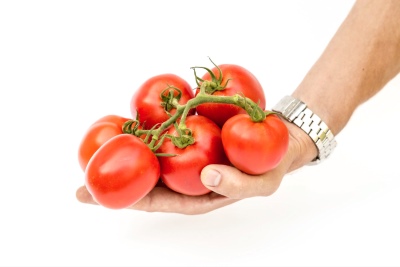
- Authors: Kiramov O.D., originator - V.I. Blokin-Mechtalin
- Year of approval: 2017
- Name synonyms: High-society F1
- Category: hybrid
- Growth type: indeterminate
- Appointment: fresh consumption, for pickling and preserving
- Ripening period: early
- Ripening time, days: 95-100
- Growing conditions: for open ground, for film greenhouses, for closed ground
- Bush size: tall
Tomato is a favorite vegetable, eaten fresh, processed and canned, so every summer resident tries to grow tomatoes in his area. One of the unpretentious and versatile varieties is considered to be the early ripening variety Velikosvetskiy.
Breeding history
The hybrid variety Velikosvetskiy was developed by Russian breeders of the Partner company. The nightshade crop has been included in the State Register and approved for use since 2017. The author of the variety is Kiramov. Despite the fact that this type of tomato is relatively new, it managed to win the attention of gardeners and farmers.
Description of the variety
The nightshade crop belongs to the class of hybrids. It represents tall bushes of an indeterminate type of growth, reaching a height of 2 meters. The bush is characterized by strong stems, moderate thickening with dark green leaves of the usual form, intermediate inflorescences and a powerful root system. Due to the fact that the height of the bushes is huge, they must be tied up. Experts recommend regular pinching and the formation of bushes in two trunks.
The main qualities of the fruit
The fruits of the Velikosvetskiy variety grow medium-sized - the weight of the fruit is 135 grams. Tomatoes are distinguished by a cuboid shape with a barely pronounced ribbing and a bright red color in a state of full ripeness. In an unripe form, the fruits are green, with a dark spot at the base. The peel of tomatoes is thin, but dense, so cracking tomatoes are not scary. The fruits tolerate transportation well, and their keeping quality is high.
Taste characteristics
The taste of the tomatoes is assessed as excellent. The pulp of the fruit is fleshy, juicy, practically without seeds. The taste is dominated by sweetness and aroma of freshness. The variety is universal, therefore it does not lose its taste when pickling, canning, processing into sauces, juices and dressings. Fresh tomatoes are ideal in salads.
Ripening and fruiting
Tomato is a high-society early ripe. From the emergence of the first shoots to harvest, only 95-100 days pass. The active fruiting phase occurs at the end of July - August / September. The fruits ripen gradually, without crumbling.
Yield
The yield of the variety is high. Subject to agricultural technology, up to 20 kg of tomatoes are harvested from 1 m2. 5 kg of fruits are harvested from one plant. This is possible due to the sheer size of the bushes. Experienced gardeners increase yields by forming bushes into two stems.
The timing of planting seedlings and planting in the ground
Seeds for seedlings are planted 60 days before the expected planting of bushes in open ground. March is considered a good time for sowing. The seeds are pre-sorted, disinfected and hardened. For planting, universal soil and peat pots are suitable. To accelerate the seed germination process, it is recommended to create a greenhouse effect using polyethylene in the first week. Seeds grow well in a warm and well-lit room. After the appearance of 2-3 true leaves, the seedlings dive in different pots. A couple of weeks before transplanting to a permanent place of growth, it is recommended to harden the seedlings, taking them to fresh air for 15-30 minutes.
Ready for planting in the ground is a bush with 8-9 leaves, a stem 1 cm thick and one flower brush. Planting of seedlings in the ground occurs in May-June (depending on the climatic characteristics of the region), when the soil is sufficiently warmed up, and the night frosts have passed.

Growing tomato seedlings is an extremely important process, because it largely depends on whether the gardener will be able to harvest at all. All aspects must be taken into account, from seedbed preparation to planting in the ground.
Landing scheme
The optimal planting pattern is 80x40 cm. It is not recommended to plant more than 3 bushes per 1 m2.

Growing and care
The culture is grown in a seedling way. The soil is pre-cleaned, it is well dug up, allowing the soil to breathe, top dressing is applied and holes are made. Do not forget about installing supports to which the bushes will be tied.
Tomatoes require complex care - watering, feeding, pinching, airing and pollination (if growing in greenhouse conditions), garter.




A plant needs different micronutrients at each stage of growth. All fertilizers can be divided into two groups: mineral and organic. Folk remedies are often used: iodine, yeast, bird droppings, eggshells.
It is important to observe the rate and period of feeding. This also applies to folk remedies and organic fertilizers.
Disease and pest resistance
The plant has strong immunity to many common tomato diseases (fusarium wilting, powdery mildew, late blight and root / apical rot). As a preventive measure, treatment with fungicides is used.


Resistant to adverse weather conditions
The culture grows in almost all climatic zones, but it should be remembered that it has an intolerance to sudden changes in temperature and humidity.
Growing regions
The nightshade crop is approved for cultivation in absolutely all regions, including the northern ones.
Review overview
The Great World tomato is a favorite of many summer residents. It is characterized as a productive early ripening variety with high palatability, which does not require special care. The versatility of the variety and the shelf life are also pleasing. Of the shortcomings, the density of the peel is noted.

























































































